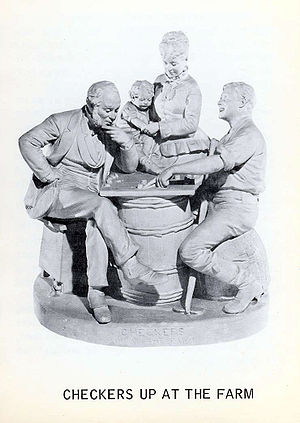
John Rogers (sculptor)
Encyclopedia


United States
The United States of America is a federal constitutional republic comprising fifty states and a federal district...
sculptor who produced very popular, relatively inexpensive figurines in the latter 19th century.
He became famous for his small genre sculptures, popularly termed "Rogers Groups", which were mass produced in cast plaster. A total of 80,000 copies of almost 80 Rogers Groups were sold across the United States and abroad.
At the height of their popularity, Rogers' figurines graced the parlors of homes in the United States and were found as far away as Chile and Australia. The English novelist Charles Reade
Charles Reade
Charles Reade was an English novelist and dramatist, best known for The Cloister and the Hearth.-Life:Charles Reade was born at Ipsden, Oxfordshire to John Reade and Anne Marie Scott-Waring; William Winwood Reade the influential historian , was his nephew. He studied at Magdalen College, Oxford,...
furnished his home with all the Rogers figurines available to him, and in the Dakota Territory, Lt. Col. George Custer and his wife had one. Often selling for $15 apiece, the figurines were affordable to the middle class.
Instead of working in bronze and marble, he sculpted in more affordable plaster, painted the color of putty to hide dust. Rogers was inspired by popular novels, poems and prints as well as the scenes he saw around him.
Life
Rogers was born in SalemSalem, Massachusetts
Salem is a city in Essex County, Massachusetts, United States. The population was 40,407 at the 2000 census. It and Lawrence are the county seats of Essex County...
, Massachusetts
Massachusetts
The Commonwealth of Massachusetts is a state in the New England region of the northeastern United States of America. It is bordered by Rhode Island and Connecticut to the south, New York to the west, and Vermont and New Hampshire to the north; at its east lies the Atlantic Ocean. As of the 2010...
, to an unsuccessful but well-connected Boston merchant and attended Boston English High School
English High School of Boston
The English High School of Boston, Massachusetts is the first public high school in America, founded in 1821. Originally called The English Classical School, it was renamed The English High School upon its first relocation in 1824. The current building is located in Jamaica Plain.-History:Since its...
, where the boy studied drawing, English and natural science. He began his career as a machinist
Machinist
A machinist is a person who uses machine tools to make or modify parts, primarily metal parts, a process known as machining. This is accomplished by using machine tools to cut away excess material much as a woodcarver cuts away excess wood to produce his work. In addition to metal, the parts may...
and draftsman
Technical drawing
Technical drawing, also known as drafting or draughting, is the act and discipline of composing plans that visually communicate how something functions or has to be constructed.Drafting is the language of industry....
at the Amoskeag Locomotive Works
Amoskeag Locomotive Works
The Amoskeag Locomotive Works, located in Manchester, New Hampshire, built steam locomotives at the dawn of the railroad era in the United States....
in Manchester, New Hampshire
Manchester, New Hampshire
Manchester is the largest city in the U.S. state of New Hampshire, the tenth largest city in New England, and the largest city in northern New England, an area comprising the states of Maine, New Hampshire, and Vermont. It is in Hillsborough County along the banks of the Merrimack River, which...
. In 1856 and 1857 he worked as a mechanic on the Hannibal and St. Joseph Railroad
Hannibal and St. Joseph Railroad
The Hannibal and St. Joseph Railroad was the first railroad to cross Missouri starting in Hannibal in the northeast and going to St. Joseph, Missouri, in the northwest...
in Missouri
Missouri
Missouri is a US state located in the Midwestern United States, bordered by Iowa, Illinois, Kentucky, Tennessee, Arkansas, Oklahoma, Kansas and Nebraska. With a 2010 population of 5,988,927, Missouri is the 18th most populous state in the nation and the fifth most populous in the Midwest. It...
. After an artistic training at Rome
Rome
Rome is the capital of Italy and the country's largest and most populated city and comune, with over 2.7 million residents in . The city is located in the central-western portion of the Italian Peninsula, on the Tiber River within the Lazio region of Italy.Rome's history spans two and a half...
and Paris
Paris
Paris is the capital and largest city in France, situated on the river Seine, in northern France, at the heart of the Île-de-France region...
(1858-59) he exhibited upon his return to the United States the "Slave Auction" (1860), which first brought him into prominence, and in 1860-65 he executed a series of war statuettes groups in gray clay, among which were the "Picket Guard," "One More Shot," and "Union Refugees."
In 1878 he opened his small studio
John Rogers Studio
The John Rogers Studio and Museum is the preserved studio in New Canaan, Connecticut, of sculptor John Rogers, a popular American artist called "the people's sculptor" in the latter 19th century. Run as a museum by the New Canaan Historical Society, the studio houses a collection of "Rogers...
in New Canaan, Connecticut
New Canaan, Connecticut
New Canaan is a town in Fairfield County, Connecticut, United States, northeast of Stamford, on the Fivemile River. The population was 19,738 according to the 2010 census.The town is one of the most affluent communities in the United States...
. The popularity of Rogers' figurines was already declining when poor health forced his retirement in 1893 or 1894 and had passed entirely by the time of his death in 1904.
Recognition
"His statuettes are almost forgotten now", according to an article published in the New York Evening Journal on October 19, 1904. "They grew out of the war; they died with the war. Yet they did their work well and possibly our present taste in art would not have been acquired had John Rogers' figurines never existed."Though provocative, and perhaps true in 1904, the year of Roger's death, the previous quote is not entirely indicative of the fact that Rogers' works continue to be popular today, and actually have tremendous value. In fact, the sculpture Wounded to the Rear, One More Shot, standing 19" tall sold for $4,800 at auction. However, it is important to note that this example of "One More Shot" was in parian, an unglazed porecelain, not the usual plaster that Rogers Groups are normally found. The parian pieces were made in England by at least two companies, J. Cooke and Robinson & Leadbeater. There may have been other makers of these parian Rogers Groups. While not definitive, it is assumed these copies were unauthorized, as there is no record of Rogers having made arrangements for their manufacture. In addition to "One More Shot" at least six other Rogers works are known to have been produced in parian, as well as majolica (a glazed porcelain), including "The Wounded Scout", "Checker Players", "Camp Life, The Card Players", "Taking the Oath and Drawing the Rations" and "Union Refugees." While the parians are always white, the majolica versions have been found in red, green, beige and brown. In addition, Rogers also sculpted "The Fisher Girl" of which 11 copies were cast in England by Copeland in parian as a lottery winning for subscribers/members of the Cosmopolitan Art Association in 1861.
His studio at The New Canaan Historical Society, 13 Oenoke Ridge, New Canaan Connecticut, now known as the John Rogers Studio
John Rogers Studio
The John Rogers Studio and Museum is the preserved studio in New Canaan, Connecticut, of sculptor John Rogers, a popular American artist called "the people's sculptor" in the latter 19th century. Run as a museum by the New Canaan Historical Society, the studio houses a collection of "Rogers...
, was designated a U.S. National Historic Landmark
National Historic Landmark
A National Historic Landmark is a building, site, structure, object, or district, that is officially recognized by the United States government for its historical significance...
in 1965.

